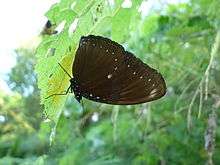Hypolimnas anomala
Hypolimnas anomala, the Malayan eggfly or crow eggfly (Chinese: 畸紋紫斑蛺蝶) is a species of eggfly.[2]
| Hypolimnas anomala | |
|---|---|
 | |
| Hypolimnas anomala. Dorsal view | |
 | |
| Side view | |
| Scientific classification | |
| Kingdom: | Animalia |
| Phylum: | Arthropoda |
| Class: | Insecta |
| Order: | Lepidoptera |
| Family: | Nymphalidae |
| Genus: | Hypolimnas |
| Species: | H. anomala |
| Binomial name | |
| Hypolimnas anomala | |
| Synonyms | |
| |
Subspecies
Subspecies include: [1]
- Hypolimnas anomala anomala (southern Thailand, Peninsular Malaya, Singapore, Sumatra, Java, Borneo, Palawan, Philippines, Bali, Lombok, Enggano, Bawean)
- Hypolimnas anomala arnoldi Fruhstorfer, 1903 (Kangean, Sumbawa, Flores)
- Hypolimnas anomala discandra Weymer, 1885 (Nias)
- Hypolimnas anomala euvaristos Fruhstorfer, 1912 (Philippines: Mindanao)
- Hypolimnas anomala interstincta (Butler, 1873) (Borneo)
- Hypolimnas anomala stellata (Fruhstorfer, 1912) (Sulawesi, Buton, Kabaena, Bangai, Sula)
- Hypolimnas anomala sumbawana Pagenstecher, 1898 (Sumbawa)
- Hypolimnas anomala truentus Fruhstorfer, 1912 (Philippines: Luzon and possibly Babuyanes)
- Hypolimnas anomala wallaceana (Butler, 1873) (Sulawesi)
Distribution and habitat
This species is present as various subspecies in South East Asia (Moluccas, New Guinea, Australia). [1] It especiaslly occurs in lowlands and tropical rainforests, wastelands, hill parks and natural reserves.
Description
Hypolimnas anomala can reach a wingspan of 65–75 mm (2.6–3.0 in).[3] These butterflies have brown forewings with a purple sheen. They show variable white markings. Usually there are a double row of white marginal spots and three pale streaks on each forewings. The hindwings are rather paler, with dark brown veins. The undersides of both wings are similar to the uppersides. In the adult butterflies only four legs are present. [4] These butterflies mimic Euploea species.
Biology
Females lay golden in colour globular eggs in a large cluster on the underside of the leaves. They hatch after about 3-4 days. The 6th (and final) instarcaterpillars are black with yellow spots and spines. Also the head is yellow. with long black cephalic horns. They are gregarious and usually occur in large numbers.
They feed on leaves of Urticaceae (Pipturus argenteus, Pipturus arboresceus, Pouzolzia, Villebrunea species ) and Euphorbiaceae (Claoxylon). [4][5][6][7]
External links
Bibliography
- Corbet AS, Pendlebury HM, and Eliot JN. 1992. The butterflies of the Malay Peninsula. Malayan Nature Society, Kuala Lumpur.
- Parsons M. 1999. The butterflies of Papua New Guinea: their systematics and biology. Academic Press, San Diego.
- Michael F. Braby, Butterflies of Australia, CSIRO Publishing, Melbourne 2000, vol. 2, pp. 566-567.
References
| Wikimedia Commons has media related to Hypolimnas anomala. |
| Wikispecies has information related to Hypolimnas anomala |
- "Hypolimnas Hübner, [1819]" at Markku Savela's Lepidoptera and Some Other Life Forms
- Catalogue of Life
- Khew Sin Khoon. A field guide to the Butterflies of Singapore
- Australian Lepidoptera
- Michael Braby The Complete Field Guide to Butterflies of Australia
- Butterflies of Singapore
- Michael F Braby Butterflies of Australia: Their Identification, Biology and Distribution